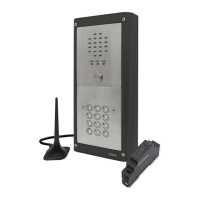66250675-EN - V1.0 - 05/09/17
41
4000 Series Vandal Resistant GSM - Technical Manual
4000 Series Vandal Resistant GSM Audio Intercom with Proximity Facility
Programming the GSM Intercom
SET AUXILIARY OUTPUT AO MODE A1M, MODES 00 02
The auxiliary output AO has up to 3 modes that can be set:
Call Activated (on during a call): nn = 00
AO output will activate when a call begins and deactivate when a call ends. See example on page 26.
User Activated (on when triggered): nn = 01 (default)
To activate the AO output either short terminals g to 5 (auxiliary 1 input AI) on the GSM intercom or press 6 on the telephone during
a call. See example on page 26.
Call Activated (Timed, on at the beginning of the call for the programmed AO time): nn = 02
AO output will activate when a call begins and deactivate when the auxiliary 1 output time (A1T) expires. See example on page 27.
1111A1Mnn Store the AO mode nn = 00 - 02.
1111A1Mnn? Store the AO mode nn = 00 - 02. Also send a conrmation text back to the sender.
1111A1M? Query the current stored AO mode. A text message will be sent back to the sender
showing the stored A1O mode.
SET DAYS TO WAIT BEFORE MAKING A CALL NOD
In the event the GSM intercom panel is not used for long periods of time it could be possible that the network disconnects it. To
prevent this from happening it is possible to program a time period (from 01 – 99 days or disabled 00) to wait before the intercom
panel makes a short call to refresh the connection to the network. This time period is reset after each call is made on the system and
will only happen if the full time period elapses without any incoming or outgoing calls.
1111NODnn Store the time nn = time in days (e.g. nn = 07, time = 7 days).
1111NODnn? Store the time nn = time in days. Also send a conrmation text back to the sender.
1111NOD? Query the current stored time. A text message will be sent back to the sender showing
the stored time.
DIVERT TIME DIT
The divert time is the number of seconds to wait for a call to be answered before diverting to the 2nd, 3rd and 4th number. The
default time is 15 seconds (the count down begins from when the call button is pressed, but is refreshed when the telephone
begins to ring) and can be set from 01 – 99 seconds.
1111DITnn Store the divert time nn = time in seconds (e.g. nn = 15, time = 15 seconds).
1111DITnn? Store the divert time nn = time in seconds. Also send a conrmation text back to the
sender.
1111DIT? Query the current stored divert time. A text message will be sent back to the sender
showing the stored divert time.
CHECK SIGNAL STRENGTH SIG
At any time the signal strength of the GSM intercom can be checked (also see notes on understanding the signal strength on page
nn). It is advisable that when the GSM is rst setup and before any other programming is carried out to check the signal strength of
the GSM intercom. If the signal strength is too low the GSM intercom may not operate properly and therefore the GSM antenna will
need to be repositioned to increase the signal strength. Use the following command to check the signal strength.
1111SIG? Check the signal strength of the GSM intercom and send a conrmation text back to the
sender.
CHECK SOFTWARE VERSION VER
It is possible to check the current version of software on the GSM intercom. This may be necessary to see if an update is required for
any additional features or updates on the GSM intercom which may be included on later versions. Use the following command to
check the software version.
1111VER? Check the software version of the GSM intercom and send a conrmation text back to
the sender.

